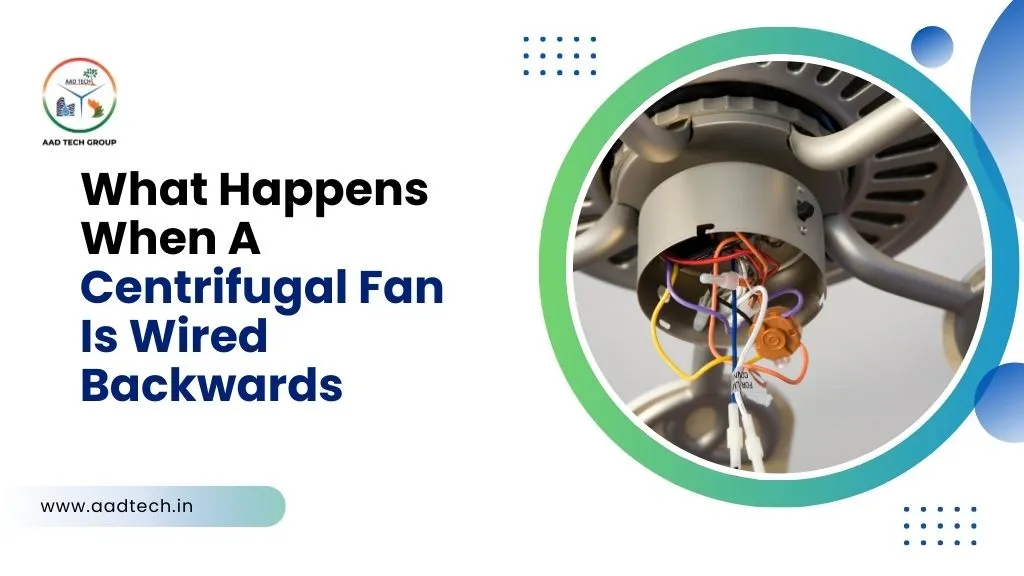Centrifugal fans are a key part of industrial and commercial HVAC operations, providing effective airflow for heating, ventilation, and cooling. Yet improper installation or wiring mistakes can cause substantial performance issues. One of the most basic yet overlooked issues is a centrifugal fan being wired in reverse.
Learning what the impact of this error is, how it can be identified, and how to avoid it is critical to preserving system performance and equipment life. Industry professionals such as AAD Tech specialize in designing and retrofitting high-performance fan systems free of such faults.
What Does ‘Wired Backwards’ Mean?
In an electric centrifugal fan, a motor is made to rotate in one direction to provide correct airflow. “Wired backwards” is a condition where the wiring to the fan motor makes it rotate opposite the design specification. This error occurs during installation or following maintenance when improper wiring is connected.
Immediate Effects of Backward Wiring
- Decreased Airflow Performance
The most apparent impact is a significantly decreased airflow. Centrifugal fans are engineered to blow air outward through specially angled blades. When the motor runs in reverse, the blades do not make air move effectively, commonly creating no or minimal flow. This creates inadequate ventilation or cooling, degrading system performance.
- Increased Energy Consumption
When a fan spins in reverse, the system must do extra work to provide the desired airflow, resulting in higher energy use. Rather than operating efficiently, the motor works against design restrictions, consuming energy and driving up operating expenses.
For a deeper look into industrial fan types beyond centrifugal designs, don’t miss our blog on The Fundamentals of Industrial Fans: Understanding Fan Classifications
- Excessive Vibration and Noise
Backward operation results in a mechanical imbalance. The dynamics of airflow are disrupted, tending to generate excessive vibrations and noise. Gradually, this increases wear and tear on the bearings and other mechanical parts, shortening the life of the fan.
- Possible System Overheating
In applications where the centrifugal fan is used for cooling electrical apparatus or airflow to control air quality, inadequate airflow will result in overheating or inadequate air exchange. This can lead to safety risks and system malfunctions.
How to Detect Backwards Wiring
- Decreased Airflow Output: Abnormal reduction in air flow despite regular supply of power should arouse suspicion.
- Unusual Noise or Vibration: Excessive noise, rattling, or vibrations during fan operation may indicate reverse rotation.
- Visual Inspection: Observing the fan in operation (if possible) can help verify the rotation direction. Most centrifugal fans have an arrow indicating the correct rotation.
- Measuring Electrical Phase: Using a phase rotation tester helps confirm whether the three-phase wiring is connected correctly.
Understanding wiring issues is only part of the bigger picture. If you’d like to explore more about fan design, check out our blog on The Differences Between Forward and Backward Centrifugal Fans
How to Fix the Problem
Reversing reversed wiring is an easy procedure for a professional technician:
- Switch Off Power: Always ensure the power supply is safely switched off prior to inspecting wiring.
- Check Wiring Diagram: Check the manufacturer’s wiring diagram in order to know the right connection.
- Reverse Phases: For a three-phase motor, reversing any two power supply phases will reverse the motor direction. This reverses the fan’s rotation but will not affect functionality.
- Test After Adjustment: The system should then be tested after it has been rewired to ensure proper functioning, appropriate airflow, and no unusual noise or vibration.
Why Professional Installation Matters
Dealing with experts like AAD Tech guarantees that centrifugal fans are properly installed and commissioned the very first time. Their fan retrofit, high-efficiency motor replacement, and system balancing expertise avoid prevalent installation errors, such as reverse wiring. Expert service spares businesses money, energy loss, and mechanical breakdowns.
Conclusion
Reversing the wiring of a centrifugal fan can be an easy mistake, but its implications are wide-ranging: decreased airflow, higher energy consumption, equipment wear and tear, and even safety risks. Catching this issue early through regular inspections and coordinating with seasoned experts guarantees your HVAC or industrial system runs at maximum performance. For long-term reliability and effectiveness, working with tried-and-tested providers like AAD Tech provides the assurance that your fan systems are installed, serviced, and upgraded properly.

